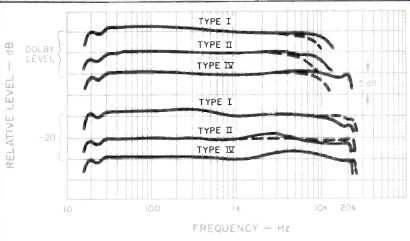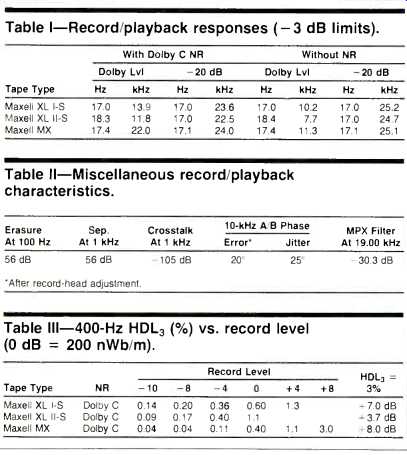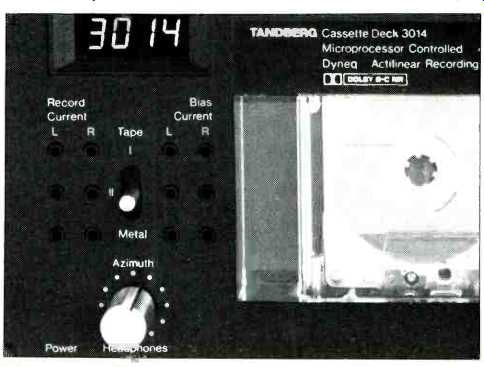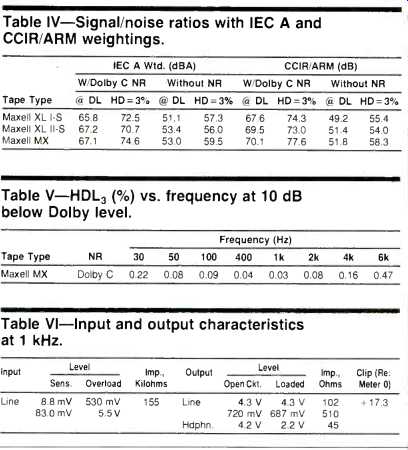
Manufacturer's Specifications:
Frequency Response: 18 Hz to 20 kHz; to 23 kHz with metal tape.
Harmonic Distortion: 1%.
Signal/Noise Ratio: 74 dBA with Dolby C NR.
Separation: 40 dB. Crosstalk: -60 dB.
Erasure: 80 dB.
Input Sensitivity: Line, 10 to 100 mV, adjustable.
Output Level: Fixed output, 700 mV; variable output, 0 to 4 V.
Flutter: 0.09% wtd. rms; ±0.12% wtd. peak.
Dimensions: 17 1/8 in. (435 mm) W x 6-9/16 in. (166 mm) H x 13 3/4 in. (350 mm) D.
Weight: 21.6 lbs. (9.8 kg).
Price: $1,395.00.
Company Address: Labriola Court, Armonk, N.Y. 10504.
The TCD 3014 is Tandberg's newest cassette deck and the latest addition to their 3000 series. The deck features advanced design, using discrete components instead of ICs wherever possible, phase-compensated amplifiers and high-grade capacitors. It has separate record and playback heads for best performance and monitoring while recording.
To maximize performance with any tape, adjustments for bias, sensitivity and record-head azimuth can be made with controls on the TCD 3014's front panel.
The peak-reading meters are equalized to give better indication of maximum allowable levels before tape saturation. The TCD 3014 features Tandberg's patented Dyneq system (which automatically varies record EQ for best high frequency recording) and Actilinear II (which increases the headroom of the record amplifier). This deck also includes both Dolby B and Dolby C NR. The transport is built on a heavy aluminum baseplate for rigid and stable support of the four-motor, closed-loop, dual-capstan drive. The two reel-hub motors are slaved to provide constant tape speed, even in fast wind and cue and review modes. The two capstan flywheels are not identical, to minimize resonances, and are belt-driven by the capstan motor. The fourth motor shifts the head assembly and performs other functions in a non-shock fashion, replacing the usual solenoid. A built-in microprocessor controls the normal transport operations as well as a number of memory and auto-wind functions. It also calibrates individual tapes for exact indications of elapsed time, even in fast forward and rewind. An optional, infrared remote control costs $150. The TCD 3014's front panel is dominated by the projecting cassette compartment. Turning on the power (at the lower left) illuminates the meters (at the upper right) brightly, while the counter display (upper left) shows "0000" after warming up for a few seconds. A red light above the "Release" button (furthest left of the six large, round transport-control buttons) shows that the transport is unlocked, for easy insertion of a cassette. In all other modes, including stop, the tape is snugly held in place until "Release" is pressed again.
The play and fast-wind functions require only a touch of the appropriate buttons. Recording can be initiated from either play or stop mode, but only if the "Rec. Preset" lever (just beneath the "Record" button) is switched on-a nice touch that helps prevent inadvertent erasures. The recording indicator, just above the button, flashes when the preset is on and glows when the deck is recording. The 3014 is unusual in that it not only allows punch-in recording but also can be switched back into play mode without stopping the tape--a definite nicety. Another nice touch is that the recording indicator will not light or flash if the cassette's erase prevention tabs have been removed, showing immediately that the tape cannot be recorded unless the holes are covered again.
The "Memory" ("Stop/Off/Repeat") switch works with the "Set" button just below "Release." With the "Memory" switch at "Stop," the "Set" button resets the counter to zero, to mark the automatic stop or rewind point. And with the "Memory" switch at "Repeat," the "Set" button records the displayed counter setting as the automatic start point.
Pressing "Stop" and "Set" together switches the counter readout between conventional counting and elapsed-time display. The time display is calibrated to match C-90 tapes, but pressing both "Release" and "Set" recalibrates it for the tape length actually in use. The calibration includes automatic rewinding to the beginning, playing, two short sections of tape, and rewinding back to the start of the tape again--accomplished in about 20 S plus any rewind time needed. I liked the combination of memory and counter features, especially the elapsed-time readout, which keeps its calibration even in fast winds.
The fast winds have constant tape speed for controlled tape tension. The winding speed is 60 times play speed, so that 1 S of wind equals 1 minute of play anywhere along the tape. Winding speeds are reduced by holding the corresponding button in, and the tape can be shuttled back and forth easily by rocking between the two fast-wind buttons; the tape stops if both are released at once.
The cue and review modes, at 20 times normal speed, are locked in by touching the "Play" button while holding either fast-wind button down. Here, too, the tape can be shuttled.
Pressing the "Stop" button during a fast wind starts the auto search function, which skips ahead or back for up to nine selections, depending on how many times the "Stop" button s pressed.
Input levels are set by a large-knobbed "Master Control" and a center-detented "Balance" pot. I prefer this arrangement to the usual separate channel pots, particularly when hey are the dual-concentric type with high friction. The 3014's master pot has the added conveniences of an adjustable reference-level indicator with detent and accurate decibel scaling (relative to 12 o'clock) around its periphery.
At the top of this panel section are the brightly illuminated, peak-responding level meters, which have white scales below zero (250 nWb/m, about 2 dB above Dolby level) and red above that. Each meter has a second scale, for Type IV (metal) tapes, just below the first one. Its zero is 6 dB above Dolby level-at 400 nWb/m. The white meter needles are easily seen against the meter faces. The infrared receptor or the remote control is to the right of the meters.
Along the bottom of the panel, to the left of the "Balance" pot, are the switch for "Dolby NR" selection, the "Output" level pot, and a rotary "Monitor/Test" switch. This has the usual source and tape positions, plus positions for 15-kHz and 315-Hz test signals. These signals are used when making record-head azimuth, bias, and tape-sensitivity ("Record Current") adjustments. The controls for these adjustments are to the left of the cassette well.
The 15-kHz test tone is used for azimuth adjustment, which is gauged by reading playback-head output on the meters while turning the "Azimuth" knob. When the meters peak, the record head is properly aligned to the playback head for that tape, even if the tape has some skew. Tandberg recommends doing this for every recording.
For other recording adjustments, the azimuth is set and he tape type is selected by using the three-position toggle switch above the "Azimuth" control. These steps must be taken before the bias and sensitivity controls are adjusted.
This must be done with a small screwdriver, as these controls are recessed behind the panel. Bias is correctly set when the output-meter readings for both the 15-kHz and 315-Hz test tones are equal. Record current is correctly matched to the tape's sensitivity when the meters read zero for the 315-Hz tone. These adjustments assure the best performance possible and good Dolby-NR tracking. Individual bias and sensitivity pots are provided for each channel and for each of three tape types.
The headphone jack is right under the "Azimuth" knob, a position that might lead to an inadvertent azimuth error when attempting to change listening level (though I must say I didn't do that during testing). The "Timer" switch ("Play/Off/Record") also seemed somewhat out of place to me, being below the "Stop" button on the right side of the panel.
There are the expected pairs of phono jacks on the back panel, but with a difference: The inputs have adjustable sensitivity from 10 to 100 mV, and there are two sets of outputs. One set has a fixed level of 700 mV for meter zero, while the other is controlled by the front-panel pot, anywhere from 0 to 4 V for the same meter reading. These features add greatly to the deck's flexibility in interfacing with other equipment. The deck has automatic sensing to set EQ in playback, but there is a little pushbutton switch on the back panel to get 70 µS for older Type II tapes which lack sensing holes. The multiplex filter switch is also back here, which could be inconvenient for those who record from FM units with poor pilot-tone suppression.
The top and side cover has pads on its inside surface to clamp and steady the three vertical p.c. boards (which appeared to be for the microprocessor and the Dolby NR circuitry). One of the two horizontal mother boards has power-supply, bias and motor-control circuits, while the other holds amplifier circuitry. Adjustments are labeled with parts numbers and function. The soldering is excellent, and intercard connections are made with multi-conductor cabling. The parts quality is also excellent, and the capacitors are the highest quality I have yet seen in a deck. I was impressed by the rugged transport support from a solid die-casting and the rigid U-channel box chassis, quite amenable to the use of the optional rack adaptors.
Measurements
The playback responses were within ± 1 dB for both equalizations, one of the best results I have ever measured.
Playback-level readings for such standard flux levels as 200 nWb/m were pretty accurate. The range of the record current and bias-current adjustments was well beyond that required by any present-day tapes, and excellent performance could be secured from many of them. I did, however, use the supplied tapes (Maxell XL I-S, XL II-S, and MX) in my lab tests.

Fig. 1--Frequency responses with (solid lines) and without (dashed lines) Dolby
C NR, using Type I (XL I-S), Type II (XL II-S) and Type IV (MX) tapes, alt
from Maxell.

Table I-Record/playback responses (-3 dB limits).
Table II-Miscellaneous record/playback characteristics.
Table III-400-Hz HDL3 (%) vs. record level (0 dB = 200 nWb/m).

The controls for bias and sensitivity are recessed behind the panel, so a small
screwdriver must be used to make these adjustments.

Table IV--Signal/noise ratios with IEC A and CCIR/ARM weightings.
Table V--HDL3 (%) vs. frequency at 10 dB below Dolby level.
Table VI--Input and output characteristics at kHz.
Swept-frequency responses were run with and without Dolby C NR for the usual three tape types both at Dolby level and 20 dB below that. As Fig. 1 and Table I show, the responses at -20 dB were well extended and flat within ± 1.5 dB from 20 Hz to 20 kHz for most cases, including those with Dolby C NR. The benefits of Dolby C NR at higher levels are evident for all three tape types.
Table II lists some measured record/playback properties.
At 100 Hz, erasure of metal tape was just fairly good (56 dB)--but it was an outstanding 94 dB at 1 kHz. Crosstalk was so low (-105 dB) that it was nearly impossible to measure. The tests of third-harmonic distortion versus level (Table III) showed that the Tandberg deck utilizes metal tape's potential very well. The low-distortion results are reflected in the signal-to-noise ratios given in Table IV, all excellent, although the Type II figures seem relatively low.
Table V lists the HDL3 figures for MX tape with Dolby C NR from 30 Hz to 6 kHz at-10 dB. The distortion is certainly low in mid-band, and the rises at the frequency extremes are quite moderate. It does appear that Dyneq and Actilinear II do provide benefits.
Various input and output characteristics are listed in Table VI. The line-input levels shown are for the maximum and minimum sensitivity settings of the level-set pots on the rear panel. The line-output figures listed are both for meter zero:
The 4.3-V figure was the maximum from the variable output, which could be set at any value down to zero, while the 720-mV figure is from the fixed-level output. A very high level was delivered to all headphones tried. The master input-level pot sections tracked within 1 dB over a 65-dB range, outstanding performance. The output-level pot tracked better than most, both channels within 1 dB of each other for 50 dB of attenuation. The deck's input and output polarity were the same in both "Source" and "Tape." Checks of the nondefeatable subsonic filter indicated a response down 3 dB at 16 Hz,-10 dB at 10 Hz, and-20 dB at 6 Hz-useful to remove record-warp contributions. Bias in the output was quite low during recording. The waveforms for the 315-Hz (304-Hz actual) and 15-kHz (14.6-kHz actual) test tones were fine for their intended purposes.
The peak-responding meters are truly that, for they reach full deflection, within 1 dB, with a 2-mS tone burst and rise the correct 6 dB when the tone burst is offset so its peak (or bottom) value, rather than its middle value, corresponds to 0 V. Very few recorder meters show such peak levels correctly.
The meters also had a good 20-dB decay time of 1.9 S. The meter-scale calibration was very close relative to zero, with most points within 0.2 dB. In "Release" mode, the meter frequency response was 3 dB down at 19 Hz and 45.6 kHz.
In "Stop" (or play or record modes), the response showed the effect of record equalization--about 3 dB of boost at the lowest frequencies, increasing to 7 dB at 15 kHz.
The playback of a recorded 3-kHz tone showed barely measurable speed variations when line voltage varied anywhere from 110 to 130 V. The record/playback flutter was very low: 0.035% wtd. rms and ±0.05% wtd. peak. Tape play-speed deviations over time stayed within ±0.01%. Wind/rewind was smooth but fast, taking just 38 S for a C-60 (one way) and ending with a non-shock stop. Tape slack was taken up before tape drive began. All changes in mode required 1 S or less.
Use and Listening Tests
The owner's manual provides good basic instruction, but it would benefit from greater detail. On the other hand, there is a quick-reference guide card, with the microprocessor functions covered on one side and record-optimization adjustments on the other-a handy reminder to keep next to this Tandberg deck.
Tape loading is simple--just push the cassette in. Removal is just as simple, but the deck must be in "Release." Access for cleaning or demagnetizing the tape path is excellent, and a push-in dust cover helps keep dirt out of the tape well when the deck is not in use.
I particularly liked the 3014's elapsed-time counter, the record preset and the smooth, high-speed winding. With some practice, most of the special button pushing, such as "Record" plus "Stop" for record-mute, seemed quite logical. Going into "Record" and back to "Stop" generated soft clicks which were just out of the tape noise with Dolby C NR. Setting levels was very easy with the meters, thanks to their excellent dynamic response and their high visibility under any lighting condition. I decided there was validity in the Tandberg approach of having the meters display the input level during recording even with the output monitor set for "Tape." With level-monitoring of the source signal, there is better indication of momentary peaks that might be reaching the tape saturation level.
The wireless remote control worked very well, and it was not necessary to point it exactly at the receptor window on the deck. Its range appeared to be at least 30 feet.
Sometimes during the listening tests, I felt that I could pin down specific differences between the sounds of source and playback, but when the in/out levels were very closely matched, it became difficult to tell. Discs for the tests included the dbx-encoded Nautilus release of Tim Weisberg's Tip of the Weisberg and the Mobile Fidelity release of the Beethoven Ninth Symphony recorded for London by Sir Georg Solti and the Chicago Symphony Orchestra and Chorus. It was easy to relax and enjoy the Tandberg deck: The sound was detailed, but also sweet.
The 3014 does not have a sophisticated music-selection programming mode, but it has many other features for the serious user: A rugged transport for long-term reliability, elapsed-time metering, fast winding with low tension, excellent level metering, and facilities to match any tape that might be used. These and other niceties, in combination with its excellent performance, make the Tandberg TCD 3014 worthy of consideration by critical users, including comparison to other decks costing much more.
-Howard A. Roberson
(Audio magazine, Sept. 1984)
Also see:
Tandberg Model TD 20A Open-Reel Tape Deck (Mar. 1979)
Studer-ReVox Model B77 Open-Reel Tape Recorder (Sept. 1978)
OPEN-REEL vs. CASSETTE (April 1977)
= = = =